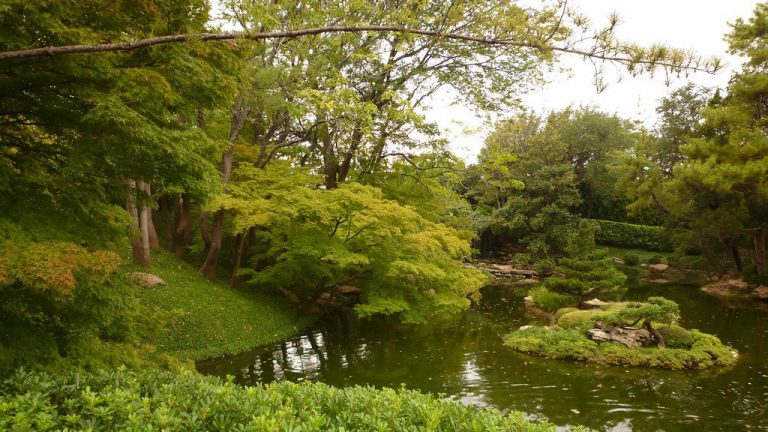While many visitors to the Fort Worth Botanic Garden may not understand the importance of the South Woods urban forest, it plays a vital role in the well-being of our city, and recent work by the Fort Worth Botanic Garden and TCU has demonstrated that the space is vital to improving the environmental, economic and social well-being of the surrounding area.
The study, overseen by Assistant Professor Brendan L. Lavie and several TCU students, took a comprehensive approach to find and evaluate the benefits of this section of the FWBG. Using field measurements, satellite imagery analysis and ecosystem services modeling, the group was able to quantify the impacts the forest has on the local environment, according to the release.
Some of the highlights of the study were the conclusions that trees provide numerous benefits to surrounding urban areas, including improving air quality, regulating climate, maintaining biodiversity, managing water and providing social and psychological well-being.
Early botanical gardens were essentially open public spaces where plants were grown, labeled, and cataloged. Originally built as large greenhouses for plant conservation and study, these spaces were primarily visited by avid and amateur botanists. Today, as cities such as Fort Worth and other urban areas continue to expand, the role of botanical gardens is increasingly becoming a place where city dwellers can visit to connect with nature and escape the asphalt jungles of their immediate surroundings.
“Urban forests contribute greatly to human well-being and environmental health, and it is important to ensure that their benefits continue for current and future generations,” said Dr Ravi. “Through this unique collaboration, students had the opportunity to deepen their understanding of the value and benefits of trees, while learning how to conduct proper field surveys and report results.”
In addition to the aesthetic and mental health benefits, Southwoods provides quantifiable economic benefits, including:
Carbon Storage: Carbon stored is estimated at 490 tons, equivalent to taking 106 cars off the road per year. Carbon Sequestration (Capture and Transformation of Carbon): Carbon sequestered is estimated at 13.42 tons per year, equivalent to the weight of over 13 male bison. Spill Avoidance: Spill avoidance is estimated at 176,002.87 gallons per year, equivalent to 563,209 Stanley Cups. Pollution Removal: Pollutants removed are estimated at 11,977.47 ounces per year, equivalent to the weight of a large grizzly bear. Oxygen Production: Oxygen production is estimated at 35.78 tons per year, equivalent to the weight of 4.5 T-Rex dinosaurs. Replacement Value of the South Woods: The replacement value is estimated at $3.42 million, equivalent to the price of an island for sale off the coast of Scotland.
“This collaboration was an opportunity to combine our strengths to drive innovation and efficiency with the mutually beneficial goal of assessing the ecological value of urban forests,” says Seth Hamby, FWBG’s Director of Living Collections. “We strongly believe that hands-on time in nature is essential to fostering a lifelong passion for conservation for everyone, and we look forward to seeing many more projects like this in the future!”
How it will be done in the future
Based on the study findings, FWBG plans to implement several initiatives aimed at protecting and enhancing the Southwoods urban forest, including:
Tree planting program: We will expand our tree planting efforts to increase canopy coverage and maximize the benefits of the urban forest. Educational outreach: We will develop educational programs and workshops to raise awareness about the importance of plants and urban forests and engage the community in conservation efforts. Collaborative research projects: We will continue to partner with institutions such as TCU to conduct further research on the benefits of urban forests and develop innovative solutions for urban sustainability. Conservation: Through FWBG’s research and conservation arm, the Botanical Research Institute of Texas (BRIT), we will continue our work with the goal of increasing understanding and appreciation of the plant kingdom, focusing on plant conservation and research centered on biodiversity, evolution, and conservation. Ash tree treatment: We will spray certain ash trees with an insecticide to combat the emerald ash borer. This treatment acts as a barrier to the beetle and prevents further burrowing. Thanks to Bartlett Tree Experts, a leading provider of scientific tree care, generously donating their services to FWBG, FWBG will be able to save 24 selected ash trees that are under threat from the invasive blue ash.
The TCU students themselves also benefited from this hands-on, real-world experience by working and conducting research in the field.
“This class provided a unique opportunity to learn about the services our local trees provide,” said Reese Reeder, a TCU environmental science student. “I really enjoyed being involved in a hands-on project. Not only did this project provide us with important information, it also benefits the community and shows the importance of spaces like the Fort Worth Botanic Garden in our urban environment.”
For more information about the research, upcoming efforts, and how you can get involved in conservation efforts through FWBG, click here


